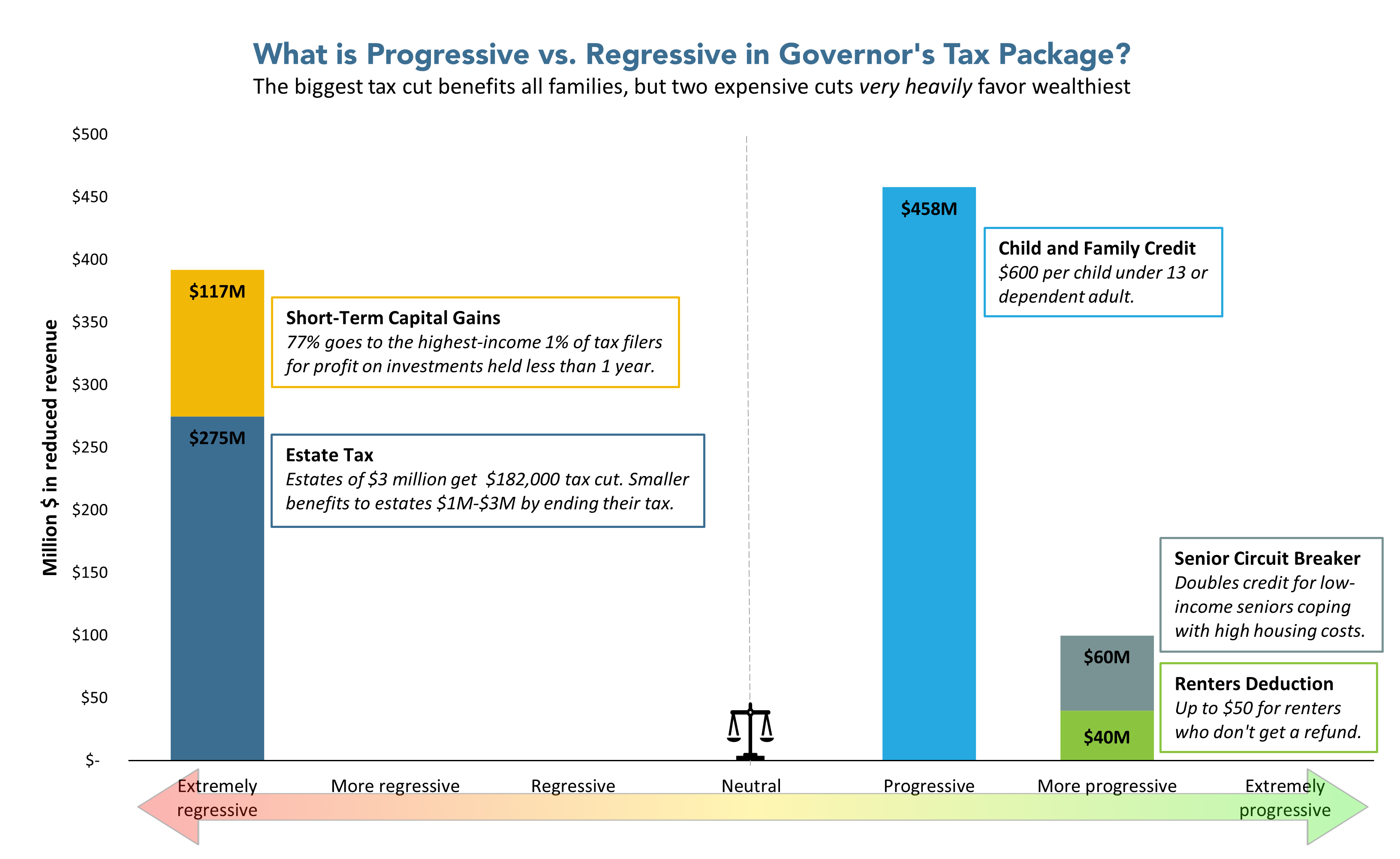Benefits for All Incomes, But Two Large Tax Cuts for Wealthiest Skew Proposal
Governor Healey’s tax relief proposal would reduce state revenue available for future investments by $986 million annually. Three proposed tax credits would be progressive, meaning the benefits for lower-income households would be a larger percent of their income than the benefits for higher-income houseolds.1 The Governor also proposes two highly regressive tax cuts, meaning richer, higher-income households would receive benefits that are a far greater percent of their income than would poor or moderate income households.
The Governor’s proposal would provide benefits to households across the income spectrum,2 but by far the largest benefits would accrue to a small number of very wealthy families.

Senior Circuit Breaker – The only tax cut explicitly targeted to taxpayers with modest incomes is a proposed increase to the Senior Circuit Breaker. The circuit breaker for tax year 2022 supported seniors with incomes below $96,000 for married couples or $64,000 for singles, living in a residence assessed below $912,000.3 If their property tax payments (or a quarter of their rent payments) exceed 10 percent of their income for the year, they can receive a credit of up to $1,200. The Governor proposed doubling this capped credit amount to $2,400. This increase is projected to cost $60 million. About 100,000 tax filers age 65 receive the Circuit Breaker credit each year.
Renter Deduction – The Governor proposes to increase the amount of rent payments that income tax filers can deduct from their taxable incomefrom a maximum of $3,000 of their rent payments to $4,000. The increase would be worth up to $50 for a tax filer (by removing an additional $1,000 of income subject to the 5 percent income tax rate). Although this deduction is available to renters of all income levels, its impact is progressive because renters have median incomes less than half as high as homeowners.4 Significant numbers of low-income renters, however, can’t make use of tax deductions because their limited taxable income is fully offset by other credits and deductions such that they already receive a refund. For these renters, an increased deduction will deliver no benefit. But overall, an estimated 95 percent of the benefits will go to the bottom 80 percent of tax filers by income. 5 Almost half of benefits will go to the bottom 40 percent. The administration anticipates the increase in the deduction will cost $40 million annually.
Child and Family Tax Credit – By consolidating, simplifying, and increasing two existing programs, the Governor would provide a $600 refundable tax credit for each child under 13 years old and adult dependents over 65 years of age or with disabilities. For example, a parent caring for two young children and an aging parent could receive an annual check for $1,800. Families would receive these credits regardless of their income level, but its impact would be greater for middle-income and especially low-income families. There would be no cap on the number of eligible dependents in a household and the credit would increase with inflation in future years. The administration projects that 700,000 households with approximately 1 million dependents would receive the credit. By making it easier for families to afford the costs of living in Massachusetts, the expanded credit would also encourage a greater supply of available workers to boost the economy. The administration projects that the additional cost for this policy would be $458 million annually.
Short-Term Capital Gains – The Governor proposes to cut the tax rate on short-term capital gains from its current 12 percent rate to 5 percent. Capital gains are the amount of profit realized by selling an investment. Like the federal government, Massachusetts taxes these gains at a higher rate when the asset has been held only a short time: less than a year.6 This encourages longer-term, patient investment instead of more speculative activities such as rapid stock trading and “flipping” real estate. Due to the highly concentrated ownership of wealth, especially in the form of financial and businesses assets, the short-term profits realized from selling these investments are extremely concentrated among the wealthiest households. In Massachusetts, the highest-income 1 percent of households would receive an estimated 77 percent of short-term capital gains cuts – an average of over $7,000 apiece. While 86 percent of tax filers in the top 1 percent claim short-term capital gains, only 8 percent of tax filers in the bottom 80 percent do so.7 Together, the bottom 80 percent of tax filers would receive only 3 percent of the total benefits from this tax cut – less than $45 on average for those receiving a tax cut. Moreover, analysis conducted by the U.S. Treasury shows that this tax cut would worsen racial inequality. Nationally, 92 percent of tax breaks on capital gains go to white families, compared to 3 percent to Hispanic and 2 percent to Black families.8 The administration estimates the annual revenue loss from its short-term capital gains tax proposal at $117 million.9
Estate tax – The Governor proposes to provide a $182,000 tax credit to large estates. Estates valued over $3 million would receive the full benefit of the tax break. Smaller taxable estates, those falling between $1 million and $3 million, would only be able to use a fraction of this credit. The annual budget cost of this policy would be $275 million.10 This proposal would be a larger revenue loss than Governor Baker’s estate tax proposal or those of the legislature last year, all of which would have eliminated taxes on estates up to $2 million. The total cost of various estate tax proposals depends most on how they would impact taxes levied on estates over the threshold. Over 70 percent of the cost of the Governor’s proposal comes from the large tax breaks given to estates over $2 million. An alternative proposal in the legislature would eliminate taxes on estates below $2 million. Like the Governor’s proposal, this would also fix the so-called “estate tax cliff.” The legislative plan would do all this at one-third of the cost of the Governor’s proposal. It accomplishes this by leaving taxes on larger estates unchanged, other than a partial reduction in tax on estates slightly above the new $2 million threshold.11
For more MassBudget analysis comparing these estate tax proposals, click here.
The Governor’s tax cuts for large estates and short-term capital gains, which overwhelmingly benefit wealthy households, would cost the Commonwealth roughly $390 million in annual revenue. As the legislature takes up this proposal, it can choose not to include these components or to substitute less expensive alternatives. The revenue freed up by that choice might then be used for other progressive tax breaks such as a boost to the Earned Income Tax Credit (EITC). The revenue savings could also be used for public investments such as reducing waitlists for vocational schools, childcare supports, or affordable housing. Each of these investments would encourage people to live in Massachusetts and would increase our state’s economic competitiveness.
Endnotes
1 Refundable tax credits are far more likely to be progressive with regard to income or race because low-and middle-income households can benefit from the full value of the tax break, even when the break exceeds the amount of tax these households owe. According to a 2023 U.S. Treasury study examining eight major types of tax break [TE or tax expenditure], “of the 8 TEs we examine, every TE that is not a refundable tax credit disproportionately benefits White families” (p. 27).
2 Not reviewed here are ten smaller tax reductions included in the Governor’s package, only six of which would have a budget impact over $1 million. The largest, an increase in housing credits for real estate developers building housing in Gateway Cities would cost $20 million in future years. A credit for qualifying live theater productions would cost $5 million. Credits for remedying residential septic systems and lead paint abatement would cost $3 million each. A proposal to exempt from taxation aid employers provide to employees for paying student loans would cost $2 million, as would increasing the cap on credits protecting dairy farmers from the impact of falling milk prices. Expanding the types of commuter benefits that can be deducted from income tax would cost $1.2 million
3 The eligibility threshold is annually adjusted for inflation, meaning that married couples with income about $100,000 or less will be eligible for tax year 2023.
4 Household median income in Massachusetts for owner-occupied households was approximately $117,036 compared to $50,644 for renting households. See U.S. Census, American Community Survey, five year pooled 2017-2021, adjusted to 2021 dollars, available at https://data.census.gov/table?q=S2503&g=0400000US25&tid=ACSST5Y2021.S2503
5 Estimates calculated by the Institute on Taxation and Economic Policy (March 2023).
6 The maximim federal tax rate on long-term capital gains is 20 percent, compared to a maximum of 37 percent for short term gains.
7 Estimates calculated by the Institute on Taxation and Economic Policy (March 2023).
8 This analysis includes both short- and long-term capital gains, as well as dividends. See U.S. Treasury Office of Tax Analysis, Working Paper 122, “ Tax Expenditures by Race and Hispanic Ethnicity: An Application of the U.S. Treasury Department’s Race and Hispanic Ethnicity Imputation” (Jan. 2023) at https://home.treasury.gov/system/files/131/WP-122.pdf .
9 This revenue loss was not included in some summaries of the cost of the Governor’s tax proposal because, as a result of budget rules that will apply this year, these capital gains revenues would have been deposited into the Commonwealth’s Stabilization (“rainy day”) fund for future spending during an economic downturn rather than budgeted for Fiscal Year 2023 spending.
10 Estates typically take several months to be processed, creating a lag in the impact of the tax cut. The administration therefore estimates that only for the first year (Fiscal Year 2024,) the cost of the tax cut would be $167 million.
11 The so-called “estate tax cliff” is an odd feature of the current Massachusetts estate tax whereby an estate currently valued at $999,999 pays zero tax and an estate valued at one dollar more pays an estate tax of tens of thousands of dollars. As a result, the recipients of an estate valued slightly above the threshold might actually wish they’d received a slightly smaller estate because the estate’s after-tax value would have been larger. This sudden onset of the estate tax has caused consternation for tax planners and some policy makers have sought to eliminate this feature. It can be eliminated, however, without foregoing large amounts of tax revenue or cutting taxes on much larger estates. The cliff can be eliminated either by revamping the entire rate schedule, by introducing a non-refundable tax credit at the threshold that phases out rapidly for higher estate amounts, or by mandating simply that no taxable estate will be reduced below the threshold amount as a result of the estate tax.





